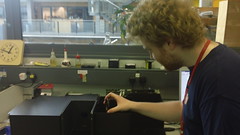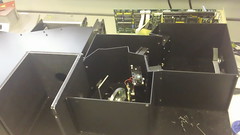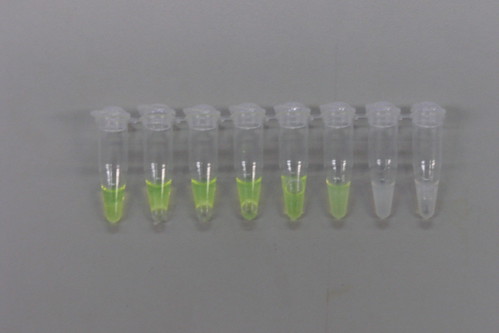Team:Imperial College London/Reporters
From 2011.igem.org
Reporters
Fluorescent reporters are an important tool in molecular biology, as they are frequently used to label various intracellular processes. In synthetic biology, fluorescent reporters are often used as the output of a genetic circuit, for example to signal the detection of a chemical.

They can also be used for stunning visual effects.
As part of our iGEM project, we implemented a new fluorescent reporter, Dendra 2. In addition, we introduced a new coding sequence for superfolder GFP that is codon optimised for E.coli.

A culture of E.coli expressing mRFP.
Each of the fluorescent reporters that we studied was transformed into 5-alpha competent E.coli cells and then grown in large batch culture overnight. The cells were then lysed and the cell debris removed, leaving the protein suspended in 20mM Tris buffer.
To further characterise these parts, we have conducted a thermostability assay to determine the temperature at which these proteins denature and cease to fluoresce.
The protocols can be found in full on our Protocols page, which can be found by clicking on the button below.
Dendra 2
Dendra 2 is a green fluorescent protein that is capable of being irreversibly photoconverted by single-photon stimulation from excitation at 486nm and emission at 505nm wavelength to 558nm excitation and 575nm emission wavelength. This means that its natural state is similar to GFP, but upon photoconversion it can be excited as RFP. Photoconversion can occur using two wavelengths 488 and 405nm (Gurskaya et al., 2006)
Photoconversion

Video 1:A time-lapse video shows the conversion of cells in area 1. The single cell in area 3 serves as a negative control. It was not bleached by the laser and therefore continued to absorb light at a lower wavelength and emit green fluorescence.
Video 2:A video of another photoconversion of Dendra in E. coli cells that have been taken up into Arabidopsis roots can be seen.
How did we photoconvert Dendra 2 whilst exciting and detecting RFP?
Using a FluoroMax-3 machine, and enlisting the expertise of Tim Wilson, we used Tim's 405nm laser to photoconvert Dendra 2. This was done by aiming the laser into the sample cuvette from above.

Tim uses his expertise to assist us.
So that we could excite Dendra 2 and measure its fluorescence as it was being photoconverted, Tim placed a filter taken from the Gel Imager in front of the detector so that we could detect the fluorescence from Dendra 2 without any interference from the excitation laser

The finished setup.

Thermostability
Raw Data

Superfolder GFP

This is a variant of GFP that has been engineered to be faster folding so that it can be used for tagging proteins more efficiently. The variant that we're submitting to the registry has been codon optimised for E.coli.
Thermostability

Samples of sfGFP from our thermostability assay. Note the colour change as the temperature increases from left to right.

GFP

This GFP expression sequence is BioBrick BBa_I13522, from the Standard Registry of Biological Parts. This is a GFP coding sequence under the control of a pTet promoter. This was taken from the registry distribution and transformed into competent E.coli cells.
This helped to form the part of our project that required the re-categorisation of existing BioBricks as we carried out a thermostability assay.
Thermostability
Raw Data

mRFP

mRFP is a monomeric form of Red Fluorescent Protein, and the expression sequence that we used to obtain our samples is BioBrick BBa_I13521 from the Registry. This is a composite part made up of the coding sequence for mRFP under the control of a pTet promoter. This was taken from the registry distribution and transformed into competent E.coli cells.
We carried out a thermostability assay on mRFP in order to add the data to the registry data sheet.
Thermostability
Raw Data

CFP

CFP, or Cyan Fluorescent Protein, was taken from the registry as composite BioBrick BBa_I13600. This is the coding sequence for CFP under the control of a pTet promoter. This will
 "
"




